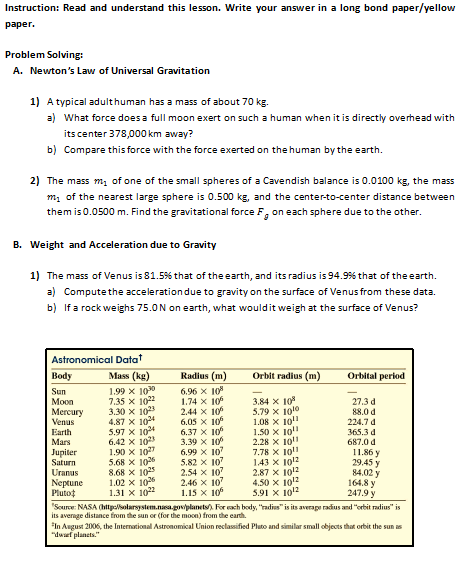1) A typical adulthuman has a mass of about 70 kg. a) What force does a full moon exert on such a human when it is directly overhead with its center 378,000 km away? b) Compare this force with the force exerted on the human by the earth.
1) A typical adulthuman has a mass of about 70 kg. a) What force does a full moon exert on such a human when it is directly overhead with its center 378,000 km away? b) Compare this force with the force exerted on the human by the earth.
Glencoe Physics: Principles and Problems, Student Edition
1st Edition
ISBN:9780078807213
Author:Paul W. Zitzewitz
Publisher:Paul W. Zitzewitz
Chapter7: Gravitation
Section: Chapter Questions
Problem 89A
Related questions
Topic Video
Question

Transcribed Image Text:Instruction: Read and understand this lesson. Write your answer in a long bond paper/yellow
раper.
Problem Solving:
A. Newton's Law of Universal Gravitation
1) A typical adulthuman has a mass of about 70 kg.
a) What force does a full moon exert on such a human when it is directly overhead with
its center 378,000 km away?
b) Compare this force with the force exerted on the human by the earth.
2) The mass m, of one of the small spheres of a Cavendish balance is 0.0100 kg, the mass
m, of the nearest large sphere is 0.500 kg, and the center-to-center distance between
them is 0.0500 m. Find the gravitational force F, on each sphere due to the other.
B. Weight and Acceleration due to Gravity
1) The mass of Venus is 81.5% that of the earth, and its radius is 94.9% that of the earth.
a) Computethe acceleration due to gravity on the surface of Venus from these data.
b) If a rock weighs 75.0N on earth, what wouldit weigh at the surface of Venus?
Astronomical Datat
Body
Mass (kg)
Radius (m)
Orbit radius (m)
Orbital perlod
1.99 x 100
7.35 x 1022
3.30 х 1023
4.87 x 104
5.97 x 104
6.42 x 102
1.90 x 1027
5.68 x 106
8.68 x 1025
1.02 x 106
1.31 x 1022
6.96 x 10
1.74 х 10°
2.44 X 10
6.05 x 10
6.37 x 10
3.39 x 10
6.99 X 10
5.82 х 10
2.54 x 107
2.46 x 10
1.15 х 10°
Sun
Moon
3.84 X 10
5.79 x 1010
1.08 X 10"
1.50 X 10!
2.28 X 10"
7.78 X 10"
143 x 1012
2.87 x 1012
4.50 x 1012
5.91 x 1012
27.3 d
88.0 d
Mercury
Venus
224.7 d
Earth
365.3 d
Mars
687.0 d
Jupiter
Saturn
Uranus
11.86 y
29.45 y
84.02 y
164.8 y
247.9 y
Neptune
Plutot
"Source: NASA (http:/solarsystem.nasa.gov/planets). For each body, "radius" is its averape radius and "orbit radius" is
its average distance from the sun or (for the moon) from the earth.
FIn August 2006, the International Astronomical Union reclassified Pluto and similar small objects that orbit the sun as
"dwaef planets."
Expert Solution
This question has been solved!
Explore an expertly crafted, step-by-step solution for a thorough understanding of key concepts.
Step by step
Solved in 2 steps

Knowledge Booster
Learn more about
Need a deep-dive on the concept behind this application? Look no further. Learn more about this topic, physics and related others by exploring similar questions and additional content below.Recommended textbooks for you

Glencoe Physics: Principles and Problems, Student…
Physics
ISBN:
9780078807213
Author:
Paul W. Zitzewitz
Publisher:
Glencoe/McGraw-Hill

Glencoe Physics: Principles and Problems, Student…
Physics
ISBN:
9780078807213
Author:
Paul W. Zitzewitz
Publisher:
Glencoe/McGraw-Hill